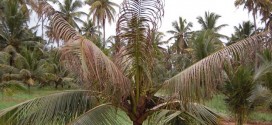Around 22% of the total cropped area which comes to around 0.65 m ha. is the irrigated area in Kerala. About 90% of total irrigation water is used for food crops of which 80% on rice and 10% on other food crops: A number of irrigation projects have been taken up in Kerala. When all the ongoing and envisaged projects are completed, it is expected to benefit about 0.2 m hectares.
Since population is high, area of cultivation is proportionately high compared to geographical area of the state. Now-a-days, the state has developed commercial agriculture more than food crops. According to 1992-93 survey, out of 30.211akh hectares, the share of food crops (cereals, millets, pulses and tapioca) was only 23 percent. A wide variety of crops preferring cool; humid climate are cultivated.
Kerala has unique cropping pattern. It accounts for 92% of India’s rubber production, 70% of coconut, 60%’of tapioca and almost 100% of lemon grass oil. Rubber, coconut and tapioca are grown in low elevation under humid-tropical conditions. Crops like tea, coffee, cardomom are cultivated in highlands. The crops like banana, pepper, ginger, tapioca, rubber are grown in midlands. Kerala is the single largest producer of banana also. It holds monopoly with regard to rubber and pepper. Besides the commercial crops like rubber, tea, coffee, pepper, cashew, rice is the important crop of the state as a staple food of the people. It occupies nearly 30% of the total cropped area followed by coconut 25% and tapioca 10 percent.
Rubber occupies an area of 4,37,100 hectares, tea around 34, 700 hectares coffee and cardamom 39,930 hectares as per 1992-93 survey. Refer table 2 for more details.
Table 1 : Important crops grown in Kerala
| Sl.No | Name of crop | Area (thousand hectares) |
| 1 | Rice | 807 |
| 2 | Coconut | 667 |
| 3 | Areca nut | 81 |
| 4 | Tapioca | 248 |
| 5 | Pepper | 108 |
| 6 | Cashew nut | 139 |
| 7 | Cardamom | 54 |
| 8 | Rubber | 238 |
| 9 | Tea | 36 |
| 10 | Coffee | 58 |
| 11 | Cocoa | 23 |
| 12 | Papaya | 11 |
Due to varied soil, land and physiographic and climatological features and peculiarity of fragmented holdings, Kerala has different cropping systems.
1. Coconut based fanning systems
Coconut as the major crop along with intercrops like pepper, arecanut, cocoa, banana, turmeric, ginger, small tubers, fodder and in some areas upland rice, pulses and oil seeds.
2. Rice based fanning systems
In low lands, a single crop or two crops of rice are grown depending on the availability of water as in the central region or after dewatering of impounded water as in Kayal lands of Kuttanad. In some areas, vegetables, pulses and oil seeds are grown in fallows or as summer crops. Fish farming or prawn culture is practised, after the rice crop, in the areas of water inundation.
3. Homestead farming systems
This system has been in vogue in Kerala as the agroclimatic conditions favour the raising of wide variety of crops. The farmers choose their crop combinations and livestock fish farming to suit the prevailing conditions.
Soil Fertility Status
The average values for total nitrogen area 0.03% for sandy soils and 0.05% for clayey/loamy soils. The organic carbon values range from 0.3 to 0.5% from sandy to clayey soils. Depending on the nature of the soil, phosphorus application and potassium application varies.
Micro-nutrient analysis revealed 30% of the soils are zinc deficient soils. Soils are having sufficient amounts of iron manganese, molybdenum where as copper is found in large amounts in sandy soils and less in Kari soils.
Fertilizer Recommendation for Important Crops
A fertilizer use efficiency of 30-40% for nitrogen, 10-20% for phosphorus and 50-60% for potassium can be expected under Kerala conditions. The trend in fertilizer consumption has also gone up to around 1.5 lakh tonnes. Different crops need different quantities of fertilizers and depending on the crops need, fertilizer doses are recommended. General .recommended doses for important crops are given in table 3.
Table 2 : General fertilizer recommendation for important crops
| Sl.No | Crops | Recommended doses | ||
| N | P | K | ||
| 1 | Rice (high yielding) (kg/ha) | |||
| a. Short duration varieties | 70 | 35 | 35 | |
| b. Medium duration varieties | 90 | 45 | 45 | |
| c. Local varieties | 40 | 20 | 20 | |
| 2 | Coconut (kg/palm/annum) | |||
| a. Average management | 0.34 | 0.17 | 0.68 | |
| b. Good management | 0.50 | 0.32 | 0.20 | |
| 3 | Areca nut (g/palm/annum) | 100 | 40 | 40 |
| 4 | Tapioca (kg/ha) | |||
| a. Hybrids (H-165, 1687,2304) | 100 | 100 | 100 | |
| b. M-4 and local varieties | 50 | 50 | 50 | |
| 5 | Sweet potato (kg/ha) | 75 | 50 | 75 |
| 6 | Sesamum (kg/ha) | 30 | 15 | 30 |
| 7 | Groundnut (kg/ha) | 10 | 75 | 75 |
| 8 | Banana (g/palm/annum) | 190 | 115 | 300 |
| 9 | Pineapple (kg/ha) | 320 | 160 | 320 |
| 10 | Sugarcane (kg/ha) | 165 | 82.5 | 82.5 |
| 11 | Pepper (g/vine/annum) | 100 | 40 | 140 |
| 12 | Ginger (kg/ha) | 75 | 50 | 50 |
| 13 | Cardamom (kg/ha) | 30 | 60 | 30 |
| 14 | Cashew nut (g/tree/annum) | 250 | 125 | 125 |
Techniques for Efficient Fertilizer Use
For nitrogen, techniques like split application in coastal sandy soils, foliar application etc. are being adopted by the farmers. Methods like urea coated granular, fertilizer placement care also be followed.
Application of rock phosphate in acid soils of Kerala has been found as efficient as super phosphate application. Basal application is better than split application.
Generally application of potassium along with nitrogen, phosphorus and zinc increases the grain yields. Potassium is being applied in two doses, half the quantity as basal and half, 5-7 days prior to panicle initiation of the crop.
 Karshika Keralam – A site for Agricultural Enthusiasts
Karshika Keralam – A site for Agricultural Enthusiasts

